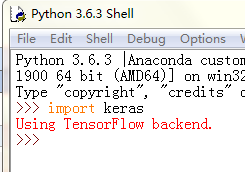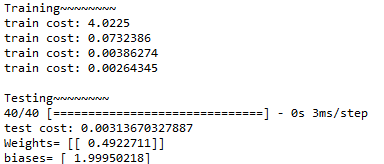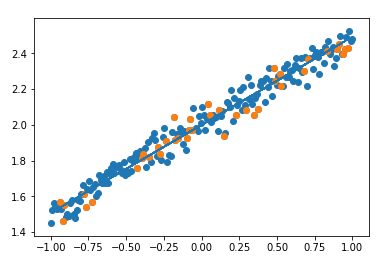首先需要下载Keras,可以看到我用的是TensorFlow 的backend

自己构建虚拟数据,x是-1到1之间的数,y为0.5*x+2,可视化出来
# -*- coding: utf-8 -*-
import numpy as np
np.random.seed(1337) #for reproducibility再现性
from keras.models import Sequential#按层
from keras.layers import Dense#全连接层
import matplotlib.pyplot as plt
#creat some data
X = np.linspace(-1,1,200) #200个x,-1到1之间
np.random.shuffle(X) #randomize the data
Y = 0.5*X +2 + np.random.normal(0,0.05,(200,))
#plot data
plt.scatter(X,Y)
plt.show
X_train,Y_train= X[:160],Y[:160]#160个
X_test,Y_test = X[160:], Y[160:]#40个

接下来搭建1层神经网络
#build a neural network from the 1st layer to the the last layer
model = Sequential()
model.add(Dense(output_dim=1,input_dim=1))#加一层
#choose loss function and optimizing method
#mse方差
model.compile(loss='mse',optimizer='sgd')
最后,训练测试,输出结果
#training
print("Training~~~~~~~~")
for step in range(301):
cost = model.train_on_batch(X_train,Y_train)#一批一批的数据,这里一批选择全部数据
if step %100==0:
print('train cost:',cost)
#test
print('
Testing~~~~~~~~')
cost = model.evaluate(X_test,Y_test,batch_size=40)
print('test cost:',cost)
W,b = model.layers[0].get_weights()
print('Weights=',W,'
biases=',b)
#plotting the prediction
Y_pred =model.predict(X_test)
plt.scatter(X_test,Y_test)
plt.plot(X_test,Y_pred)
输出结果

